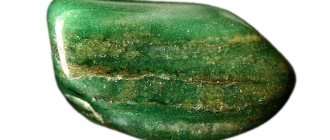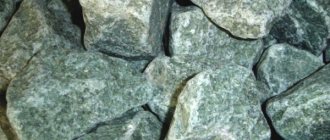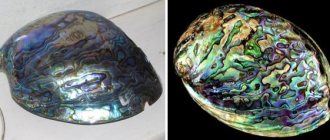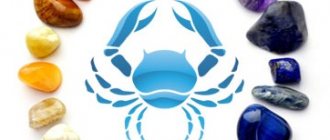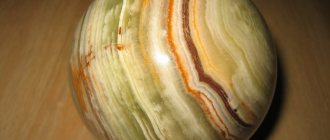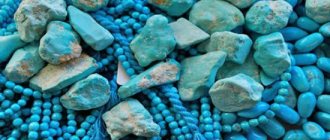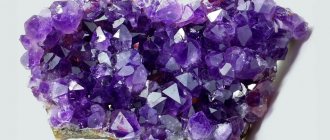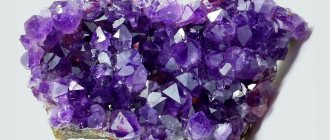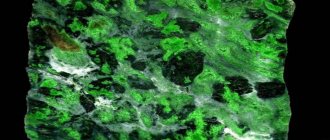For many centuries, jadeite was not separated from jade, which was similar to it, and they were called by the same word - “jad”, considering it a sacred stone.
But these are completely different minerals, with different physical and chemical properties. Possessing high hardness, the stone was used in ancient times to make weapons and other household tools. Later they began to make magnificent jewelry from it.
Properties of jadeite stone
Jadeite is a unique stone. It is sometimes simply called jade. The color of jadeites varies from red to purple. Green jadeites are especially prized. In ancient times, many jadeites came under the name jade.
Only in the second half of the 19th century, thanks to the research of the French chemist A. Damour, it was determined that many stones called jades were not at all what they were taken for. In those days, almost all jade-like stones were called jade (in Spanish, piedra de la jada means kidney stone).
Apparently, kidney diseases plagued our ancestors so much that kidney stones have been known for a long time. And jade was credited with the ability to relieve renal colic. By the way, nephritis comes from the Greek “nephros” - kidneys. Jadeite and jade were also used as a scraper or chisel (these minerals are very hard).
Jadeite had the ability not only to eliminate renal colic, but gradually with the development of civilization it became a cult stone. Among the Aztecs, the mineral was valued more than gold, and could only belong to people of noble origin. In addition, jadeite products decorated temples and were indispensable attributes in rituals, for example, in sun worship. Amulets were made from it.
In China, the stone was idolized, but for the ancient Chinese, jadeite and jade were the same stone. Here they made not only jewelry from it, but also figurines and statues. Stone was often used in the interior of the house. Simply put, in China the stone is held in special esteem.
In many corners of the Earth, jades of unique beauty and size have been found, but a stone the color of a green apple was found extremely rarely, and this is the very jadeite in question. And if such a stone was found, it could only belong to the emperor. So jadeite, the color of a green apple, received a characteristic name - imperial or “imperial”. Its prices are comparable to the prices of emeralds.
Jadeite belongs to the group of alkali pyroxenes, its chemical formula is NaAlSi2O6, and jade is a complex silicate of magnesium and iron. There are impurities in jadeite, and its color palette depends on this. And the composition of the stone may include more than 60 elements from the periodic table. High-quality types of jadeite include almost transparent minerals.
Jadeite dissolves in acids. The stone is very hard (6.5 - 7 on the Mohs scale), dense - 3 - 3.5 7 / cm3. It is difficult to break or saw through.
Color palette: all shades of green, red, yellow, lavender, white, brown, black, orange and pink jadeites are known. Since there are many varieties of color shades, names are used that more accurately describe the color, for example, cream, earthy, glassy, buttery green, dryish green...
Jadeite is divided into three trade and, at the same time, jewelry categories:
1. Imperial.
Its color is similar to the color of emerald, but still warmer, and then it has more of a yellowish tint.
2. Commercial.
Also green, opaque, has veins and spots of emerald green.
3. Utility.
Jadeites are bright green and dark green in color. These are translucent green stones with a cloudy coating.
The imperial is valued above all. Imperial jadeite is a light green stone that is extremely popular in China, Taiwan, Japan and Thailand. The price for imperial jadeite on the gemstone market is mind-boggling. Moreover, it is determined not by carat, but by the size of the stone.
Jadeite deposits
The most significant deposit is considered to be Burma, which was discovered in the second half of the 19th century. The auction “Imporium” is held here twice a year. You can see first-hand how much jadeite is idolized here. A beautiful stone can also be found in our Urals, in the Sayans in the south of the Krasnoyarsk Territory.
The price of jadeite is constantly growing. Since it is the green ones mentioned above that are valued, there are also fakes. Pale jadeites, which are very inexpensive, are dyed green. And, as experts say, it is not easy to distinguish a fake from a real imperial without special equipment. Therefore, jewelry with jadeite should only be purchased from stores that you can trust. There are experiments on artificial cultivation of jadeite.
Jadeite can be confused not only with jade or emerald, but also with chrysoprase, fluorite, and amazonite.
Story
Jadeite has been known to mankind for a long time.
He is highly revered in China. Often, the purpose of the military campaigns of the Chinese rulers was to conquer the territories where this stone was mined. The Chinese still love jadeite; the art of carving it is very developed in their country. This mineral is also valued in Japan and among all Buddhists.
Among the Indians, it was considered a sacred stone and was used to make figurines of gods and cult amulets. Many temples in Mexico are still decorated with jadeite figurines. The Indians lost the art of carving on this stone after the conquerors invaded America.
In Europe, this mineral was not distinguished from jade. Only in 1836, thanks to the French mineralogist Demur, it received its own name and was recognized as an independent stone.
It is believed that the mineral received its name from a Spanish phrase that is translated into Russian as “kidney stone.” In appearance, some of its specimens resemble a kidney, and it was believed that it relieves renal colic.
Historical tales
Here we will try to tell how jadeite came to Europe, why in China it was (and is) valued along with the most expensive gems.
The Great and Terrible Conquest
People always want money. And more. Therefore, at the end of the 15th century, the king and queen of Spain decided that in India (according to rumors) precious stones and gold were practically lying on the ground. So let a couple of Spanish ships under the command of Columbus sail to a rich country and bring back that very gold and jewelry that is always in short supply.
The boats sailed and got lost along the way. Geographic maps were bad back then. Instead of Asia, we ended up in America, which no one had heard of at that time. But they stubbornly believed that they had reached Asia. Thus began the Conquest.
The locals greeted the Spaniards as dear guests. They gave us food and drink and showed us their cities and temples.
It was then that the Spaniards realized that they had come to the right place (in the sense that they found what they were going for).
I don’t want to say what the soldiers did to the aborigines. And most importantly, they robbed churches, dragging away everything that was not nailed down. Gold, amulets, Indian relics - everything was neatly stacked in the holds of the pot-bellied ships.
Among this stuff there were objects made of stone - greenish, white, pink. The stones had the property of relieving lower back pain, and the Spaniards called them piedra de ijada - “side stone”.
Then jadeite came to Europe.
The history of the mineral in the New World (Mesoamerica) is much longer. The stone was known to the Mayan, Aztec, and other aborigines from the 8th-4th centuries BC. This is confirmed by archaeologists who come across items made from jadeite. Ritual masks and jewelry were made from it. And also knives used by priests in ritual sacrifices.
Interesting: there are archaeological finds where jadeite teeth are inserted into skulls instead of ordinary, “native” teeth. It was probably prestigious back then.
Now about China. It is incorrect to believe that jadeite and jade have been held in special esteem in the Celestial Empire since time immemorial. At first it was jade.
But the artisans who processed the stone and made precious trinkets from it had trained eyes and hands. It was the masters who noticed that the jade obtained from Burma is not always the same. Some stones were denser and heavier. Treated, they shone better. These stones were jadeites.
But scientists determined that jade and jadeite are different gems only in the middle of the 19th century.
But even a description of the minerals will not help to understand what the mysterious Chinese soul found in jadeite.
Physicochemical characteristics
According to its characteristics, jadeite is a silicate of two metals - aluminum and sodium. The chemical composition may vary slightly due to the presence of impurities of manganese, chromium and other metals. The physical properties of jadeite include a wide range of colors, matted fibrous structure, and high hardness.
- The chemical formula is NaAlSi2O6 or Na2O Al2O3 4SiO2 .
- Color - green, grayish-green, white, occasionally: violet, blue, yellow, emerald, blue, pink, black.
- The shine is glassy.
- Transparency - opaque or translucent, sometimes transparent.
- Hardness - 6,5–7.
- Density - 3.25–3.36 g / cm3 .
Outwardly, this mineral resembles jade, but their composition and formation conditions are different. Jadeite is formed under conditions of strong pressure from lithospheric plates and not very high temperatures.
Place of Birth
Jadeite is a rare stone. It is currently mined in only eight countries:
- China;
- Japan;
- Kazakhstan (Tian Shan);
- Russia (Polar Urals, Khakassia, Western Sayan);
- Mexico;
- USA;
- Guatemala;
- Myanmar.
The best is considered to be jadeite from Chinese deposits. The Russian mineral is also of high quality.
In 1916, a jadeite monlith with a record weight of 175 tons . Its cost is approximately $170 million .
Mining locations
The most beautiful jadeites are mined in Burma.
The largest deposits of the gem are located in Myanmar and Guatemala, Mexico and China.
Jadeite deposits have not been developed in Russia for a long time. But they exist. The Khakass field is considered the largest in our country. In the vast expanses of Siberia, in the tributaries of the Kantegir River, there is the country’s jadeite treasury. The stone is pure white or light gray, very transparent. Often has a bluish or greenish tint.
We recommend: World Jade DEPOSITS
Stones of this type are considered “young” jadeite. Currently, the Chinese (experts and connoisseurs, we know this) recognize Khakass jadeite as second in the world after Burmese.
The Chinese were not lucky with Ural gems. At the end of the last century, they bought a large batch of stones from the Pusier deposit. The stone looked like jewelry jadeite. However, it turned out that all the stones were covered with microcracks and were not suitable for jewelry. Mining was also carried out using blasting operations - this improved the quality of the stone.
Varieties
Jewelry-quality jadeite has several types with variations in tone and different transparency. The following varieties of jadeite exist:
- "Imperial" is the most valuable type of this stone. The color is uniform, the color is bright green, the transparency is high, but it can also be translucent. In terms of beauty and cost, jewelry with such gems is comparable to jewelry with sapphires, emeralds, and diamonds.
- “Commercial” is also a precious variety, but less expensive due to its opacity. Shades: lavender, coral, green, yellowish-green.
- Chloromelanite is an opaque variety that is dark green in color with black streaks and spots. This is an excellent ornamental stone.
- Albite (jad-albite) - specimens with chaotic “blots” interspersed with other elements. Usually the color of the stone is deep green, but it can also be white, reddish, or pink. This is a jewelry and semi-precious stone.
- “Utility” is the cheapest type, but looks elegant. One of its properties is to maintain optimal temperature, cool or hot, which is why it is used in sauna heaters to make baths.
Ennoblement, imitation - what's the difference?
Not all stones are perfect. Appearance does not always satisfy jewelers. But don’t throw away the good stuff.
In such cases, jadeites ennoble and improve their appearance:
- Coating the stone with wax. This gives a matte shine. The most harmless ennoblement.
- Bleaching. If there are stains on the stone (usually brown or yellow), then the gem is soaked in hot acid. Then (at the same time) the cracks in the stone are filled with polymer. Stones treated in this way quickly fade and become brittle. Such gems are inexpensive.
- Coloring. White and faded (lightly colored) specimens are most often painted. This way you can achieve a lavender or green tint - and sell the stone at a higher price. You can also paint jadeite in a color that nature did not think of painting the stone with. But any of these stones should cost less than untreated ones.
- Heat. Most often it affects brown and yellow stones. Heat is used to lighten the gem - or give it a reddish tint.
- Thin film coating. A thin polymer coating is applied to the surface of the mineral. Films visually improve transparency and shine, and hide flaws in the stone. Jadeite “in film” looks rich, but is cheap. Only a gemologist can see and recognize the film.
There are plenty of outright fakes on the jadeite market, but not enough natural ones. Under the guise of a gem they can sell:
- amazonite;
- green aventurine;
- chrysocolla;
- hydrogrossular;
- chrysoprase;
- tinted quartz.
Painted glass and plastics are also sold under the guise of jadeite.
Application
Jadeite is a hard mineral, but malleable to processing. This is a jewelry and semi-precious stone, and noble jadeite is a jewelry (precious) stone.
Mineral used in production:
- jewelry (rings, necklaces, earrings);
- figurines, vases, tea sets;
- hygiene supplies (sinks, bathtubs);
- home decoration;
- heaters for baths and saunas (for this, the so-called “bath jadeite” is used).
An interesting decorative element is a figurine made of untreated stone.
Jadeite is a durable stone; it can retain its beauty for centuries, but only with proper care.
What stones does it go with?
Jadeite goes well with earth element stones:
- chalcedony;
- onyx;
- agate;
- crocodilitis;
- nephritis;
- sarder;
- lapis lazuli;
- heliotrope;
- cacholong;
- malachite;
- jet;
- turquoise;
- jasper;
- onyx;
- rauchtopaz;
- morion;
- rhodochrosite;
- Labrador
Medicinal properties
In Chinese medicine, jadeite is of particular importance for humans, as it helps restore the body’s disturbed bioenergy.
Modern lithotherapists also use this mineral to normalize the energy field of patients.
The effect of using jadeite for medicinal purposes will only be if you do not refuse medications prescribed by your doctor. The stone promotes rapid recovery.
It is believed that jadeite helps with kidney diseases and urological problems. For chronic nephritis, prostatitis, cystitis, it is recommended to wear it constantly.
This stone also has a positive effect on diseases of the reproductive organs in women and men.
In Chinese medicine, among the tips for treatment with jadeite are the following:
- drinking tea from jadeite cups is useful for problems with the kidneys and bladder;
- Immersion in a bath made from this mineral will help overcome colds, joint diseases, and cramps.
It is believed that wearing certain jewelry is beneficial for various health problems:
- A ring with jadeite on the middle finger relieves eye strain and improves vision.
- A bracelet, pendant, or beads help avoid problems with the gastrointestinal tract, blood pressure, and blood vessels.
The healing properties of jadeite also depend on its color:
- White jadeite helps with weather dependence and strengthens the immune system. A bracelet or ring with a white stone is recommended to be worn during seasonal flu.
- Pink jadeite has a beneficial effect on the heart.
- Green jadeite is good for the kidneys.
The healing properties of jadeite will be more pronounced if jewelry with it is constantly worn.
Not only jadeite
Many people confuse jade, jadeite and nephrite. The color, shades and many physical characteristics of the stones are very similar. Difference in composition, melting point, viscosity.
The British called the mineral stone ax - stone for an axe . During the excavations, archaeologists of Foggy Albion found many axes made of this durable stone (Stone Age products).
In Thailand, in a specially built temple there is an “emerald Buddha”. This is a small statue carved from a single green piece of stone. A mineralogist will immediately say that this is not an emerald, but jadeite or jade... This requires special research. But, of course, no one will allow them to be done. After all, this is the mascot of Thailand.
We recommend: Luck's Favorite GREEN AVENTURINE
In India and Nepal, jadeite is believed to contain divine essence.
By the way, in the Kremlin Diamond Fund (the main treasury of Russia) there is not a single piece of jewelry with jadeite.
China is not Europe!
The preferences of the Chinese in the field of jewelry are not clear to Europeans.
Polite Chinese will agree that the four “kings of the market” are diamond, sapphire, ruby and emerald. However, the true king of the Chinese market has become jadeite (which not everyone in Europe has heard of). Sales of the gem are many times higher than the demand for the “European kings of gems.”
What diamonds, what are you talking about! Jadeite is the best investment, and jewelry with jadeite (no matter whether it is set in gold or silver) will be the best gift for any resident of the Middle Kingdom.
Why a rich Chinese would pay several million dollars for a jadeite bracelet, we will never understand...
Jade has been the main gemstone in China for thousands of years. For centuries, the Chinese have adored jade. It is unclear why this stone fascinated them. But they attributed a lot of magical and healing qualities to the gem.
Jadeite was made the imperial stone by Empress Ci-Xi (Qin Dynasty). She was introduced to jadeite products in the 18th century (these were Burmese gems). Tsy-Xi simply fell in love with the stone. And what the emperor loves, he loves to know.
For the Chinese, jadeite means wisdom and courage, justice and the ability to compassion.
Magic properties
You may not believe in omens and be skeptical of supernatural phenomena, but scientists are already recognizing the influence of precious stones on people. They associate this influence with atomic particles, with a special composition and individual radiation.
Jadeite was considered a sacred stone by the Chinese and Indians, as they noticed its strong influence on the life of the owner. Soft greenish jadeite is highly valued in Japan (and among all Buddhists), as it is believed to bring prosperity to the home.
The value of jadeite for humans lies in its protective abilities. The magical properties of this mineral include:
- Protection from any kind of negative energy, from bad events, liars, slanderers, scammers, thieves.
- Protecting the hearth, strengthening family relationships, getting rid of unreasonable jealousy and mistrust, helping to overcome periods of crisis, and establishing a close connection between parents and children.
The help of the jadeite talisman is especially evident in the following:
- Its owner becomes brave, assertive, fair, strong-willed, and believes in his own strength.
- A person finds harmony, kindness, worries leave him, he becomes independent, having his own opinion.
- During a business transaction, a jadeite talisman held in the hand will lead to success and help avoid deception.
Interesting Facts
In 2016, a huge (weighing about 175 tons) jadeite monolith was found in one of the Burmese mines. The approximate cost of the stone is at least 170 million US dollars.
The world's largest faceted imperial jadeite was presented in 1980 at an emporium (exhibition and sale) of precious stones held in the capital of Burma, Rangoon.
The cost of translucent emerald green jadeite weighing 750 carats was about 2 million US dollars.
Who is suitable according to their zodiac sign?
Astrologers have discovered how jadeite interacts with people born under different constellations. It turned out that this mineral has the greatest horoscope compatibility with those born under the constellations Leo and Libra :
- Leo, under the influence of this mineral, will pacify his temper and become calmer. Nervous tension will disappear and blood pressure will normalize.
- Libra will believe in themselves, gain confidence, and find the right path to their goals. Under the influence of the jadeite amulet, life will change for the better.
This stone also has good energetic compatibility with the following zodiac signs:
- Aries will feel the powerful energy of the talisman in that gloomy thoughts will disappear, optimism and a positive outlook on life will appear, and family relationships will improve.
- Taurus will feel an improvement in their physical and mental condition. Mutual understanding and love will reign in the relationship between spouses if one of them wears jadeite jewelry.
- Geminis under the influence of this gem will not succumb to bad influence.
- Virgo, under the influence of the magic of jadeite, will feel complete unity with nature and will successfully grow plants.
- Sagittarius will find family happiness, family ties will become stronger. If you buy a talisman in the form of a jadeite figurine and place it in a prominent place in the house, it will protect family members from ill-wishers.
- Aquarius. A talisman made from this gem will protect the owner from bad situations and bad relationships with others. The owner of the amulet will become more tolerant of people's shortcomings. But some astrologers warn that the energy of jadeite may be too strong for Aquarius and can suppress a person’s own energy. In this case, there is a danger of developing depression. So Aquarius, who decides to buy jadeite, needs to think carefully about whether it is worth it.
The energy of this stone does not coincide with the energy of people born under the constellations of the element of Water: Cancer, Scorpio, Pisces . If they wear jadeite jewelry, there is a great danger for them of apathy, pessimistic mood and selfishness. The following stones are suitable for Water signs: ammonite, ammolite, belomorite, moonstone, labradorite, sodalite, aventurine.
Another sign that jadeite is not suitable for is Capricorn . For a person born under the constellation Capricorn, the gem can cause absent-mindedness and excessive daydreaming. Stones such as sardonyx, petersite, serpentine, aragonite, obsidian, garnet, and fluorite are ideal for Capricorn.
Read also : Hematite (bloodstone ) - a healing and amulet
Talismans and amulets
Talismans and amulets made from this stone are especially popular in Asian countries, where jadeite, along with jade, has been known for a long time.
Many people could afford amulets made of ordinary jadeite, while the translucent polished mineral was the property of only the nobility and the imperial family.
Such talismans were designed to protect the family, endow their owners with patience and wisdom, and protect them from illness and misfortune. It was believed that such amulets could only be worn by highly moral people, so jadeite jewelry raised the status and reputation of the owner in the eyes of others.
Interesting! Farmers also used inexpensive gray jadeites to increase yields. They buried stones around their fields, offering prayers to the fertility gods.
Jadeite is considered the stone of lawyers. It endows its owners with insight, composure, moderate eloquence and an inner sense of justice.
Crushed jadeite was mixed with juice. Would you risk a drink?
Not really
How to distinguish from a fake
Jadeite is a very beautiful, expensive stone, so fakes are often found on sale. Of these, the most famous are doublets-plates. They consist of an inconspicuous mineral to which a thin plate of jadeite is glued.
Sometimes cheaper stones are given out for this gem:
- serpentine;
- green aventurine;
- chrysoprase;
- prehnit.
Methods for determining natural jadeite:
- Examine the stone through a magnifying glass, holding it up to a bright lamp - fibrous structures should be visible in it.
- Take a piece of granite of similar size and compare the stone with it - jadeite should be much heavier.
- Knock the two beads together. If the sound is powerful, deep, with pronounced resonance, then they are jadeite. Fake beads give a “plastic” sound.
- Squeeze the stone in your fist - real jadeite will feel like a very cold and hard bar of soap.
